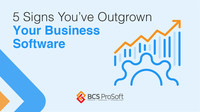Too often, we get the PANIC call from companies AFTER they have made a technology mistake that put them in a serious bind. What companies fail to realize is that technology, by its nature is a moving target and finding the best possible IT solution requires quite a lot of work. It is tempting to go “cheap” when purchasing or hiring in the area of IT, but it is important to remember that a single mistake could lead to a catastrophic loss of data.
I have been helping companies navigate the complex and confusing world of technology since 1985 and during that time, I have seen many great things come from the proper use of technology. Likewise, I have witnessed some horrible mistakes made by customers and prospects. I could provide numerous examples where technology has allowed a company to grow beyond the owner’s wildest dreams — and I have horror stories of companies that were literally put out of business due to poor technology planning and mistakes. Here is my list of the Top 10 Technology Mistakes Made by Small Businesses:
Mistake #1: No Reliable Backup
At least once each year, we get a call from a panicked customer because they needed to restore data from their backup system only to find that the backup did not include the proper data (or any data at all). NEVER (are you listening?) NEVER assume that your backup system is working properly. At least once each month you should backup a test directory, erase it, and then do a test restore. This will insure that your backup device is working, but you also need to make sure that the proper data is being backed up. Here’s a tip that could save your bacon some day: In addition to whatever backup system you have in place, go down to Best Buy and purchase one of the External USB drives (I recently saw a Terabyte drive available for under $100!) and use it to make a copy of your entire accounting/business management system. Take the drive home and make an appointment with yourself to bring it in and refresh your copy every month.
Mistake #2: Buying Cheap Equipment
You must first understand that all hardware is not created equal. The $49 router that you can pick up at Walmart simply will not perform as reliably as a business class router. Many small business owners cut corners on hardware to reduce cost and don’t realize that the cost of installing improper equipment is much higher when you consider repair costs, shorter lifespan, data corruption, and downtime. Purchase business class hardware for all mission critical applications.
Mistake #3: Overextending the technology life cycle
That five year old PC your receptionist is using probably won’t hurt business when it dies, but if the 10 year old server you are running dies it could cripple your business. All technology has a set life cycle. Manufacturers refer to the MTBF (mean time between failures) of equipment. Servers and PC’s have a life cycle of 3-5 years. The actual usable life of your equipment depends on how much the equipment is used and the operating conditions, so if you have mission critical hardware that is greater than 3-5 years old, start planning now to replace it. Don’t wait for the equipment to fail!
Mistake #4: “Set it and Forget it”
Perhaps the most common error made by small business owners is using the “Set it and Forget it” strategy for IT infrastructure. IT hardware and software requires routine and regular maintenance and adjustment. Like your automobile, you should have a regular maintenance routine for your IT System that is performed at specific intervals. Servers and software need continual care so they can perform at optimal levels. Insuring the health of your backup system (as described in Item #1 above) is but a single example of the regular maintenance required to maintain system integrity.
Mistake #6 Buying new software while skipping hardware upgrades
Software publishers are notorious for offering releases that require a significant hardware upgrade in order to run the new version. Too many small business owners purchase the newest version of the software they use without giving any consideration to new hardware requirements. The result is a failed upgrade and often that failure brings the business to a screeching halt until the old version can be reinstalled or until new hardware can be put in place. Check with software publishers to get minimum system requirements prior to installing an upgrade and make sure your existing system meets those standards. If new hardware has to be purchased, please don’t purchase to meet the “minimum” requirements – buy equipment that exceeds the minimum requirements by at least 1 or 2 levels. This will insure proper operation at the new level and will likely increase the replacement time frame.
Mistake #6: Forgoing User Training
This is a problem that’s less about equipment and more about human nature. Training is an absolute must for small businesses. Without proper training on your business systems, well-intentioned purchases will be rendered useless and you will not see the return on investment that you hoped for. You may find it helpful and cost effective to take a “train the trainer” approach with your software provider. By having one person or a small contingent of your staff trained on all facets of the software you rely on, you will have someone on staff that can provide the rest of the staff with the training required to successfully use the software.
Mistake #7: Working without a plan
Planning out your IT initiatives or upgrades is a task that should be done, at the bare minimum, once a year. Mapping out your technology path can impact your entire business. Each small business should not only budget for new hardware, software upgrades, or technological elements, but you must also consider if you will need additional manpower and/or technical support. If you plan ahead, that software upgrade or mandatory hardware migration will no longer jump out from nowhere.
Mistake #8: Skimping on security
Many small businesses find it inconceivable that someone would target their business or try to steal their valuable data. I wish I could say that this is not the case. Security has become the number one issue for IT environments in the past few years, thanks to online scams, vulnerability in software and networks using improper architecture. As an IT expert, I’ve come across small business systems that are so vulnerable, their accounting data is readily available on the Internet. Other systems have no anti-virus software or no malware protection, but plenty of insidious spy ware working overtime, capturing everything from login names to passwords. At some small businesses, I’ve seen criminals use open ports to hack into security camera footage–just to plan a robbery. Spam, malware and viruses pave the way for a devastating security breach. Don’t let it happen to you.
Mistake #9: Using under qualified people for IT support
I know, it’s tempting to hire your nephew or neighbor to support your IT infrastructure — they’re cheap and you want to help them out, but it is foolish to assume they are capable of such responsibility just because they can download and install software. An under-qualified person can never give you good IT advice. Because they’ve fallen into this trap, many small businesses actually end up spending more money just to correct the mistakes of an under-qualified IT person. If you need outside support for your IT environment, ask for certification, credentials, and references. A good IT person is always trained and certified to work within the complexities of an IT environment.
Mistake #9: Going Cheap, regardless of the consequences
Let’s face it — Technology is expensive. And I’m not just talking about the initial purchase price. When you consider the purchase price, plus the implementation and training costs, and couple that with the annual maintenance and support costs, technology is one of the most expensive investments you will make in your business. But spending money often isn’t a bad thing, as long as you spend wisely. Numerous times I have worked with prospective customers to develop a technology solution that met their initial and long term needs, only to lose the deal to a less expensive solution that met the customers immediate needs, but couldn’t scale to meet the customer’s near term growth plans. When questioned, the customer invariably says they need to save money today and will upgrade when they really need it. The problem with this strategy is that converting from one system to another is quite expensive and is also disruptive to the business. Cheaper is NOT always better.
Mistake #10: Using pirated software
Software licensing rules can seem quite unfair. Many small business owners wonder why they should purchase more copies of software when they can simply use one for all their machines. With older software, you could probably get away with this, however with today’s ultra-sophisticated software, it’s simply a losing bet. Some software companies are cracking down so hard that when you download updates, it alerts them when the software has been used more than once. A company can disable your software completely at just the click of a mouse. Even worse, you could end up facing fines of upwards of $100,000 from the Business Software Alliance. Keep your software licenses up to date and you’ll never find yourself in this situation.
These are my “Top Ten Technology Mistakes,” but I’ve seen dozens (hundreds?) of other mistakes made over and over again by my clients and prospects. Many small business owners are technology challenged and have no idea how to address these issues. If this is the case for you, I’d recommend that you find a good IT Consulting firm that can help you determine your current technology status and help you plan for the future. The investment you make now could save you thousands in the future.
Have your or your business had any technological misgivings? Share your thoughts with us.







